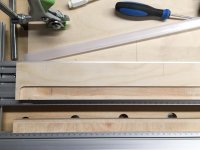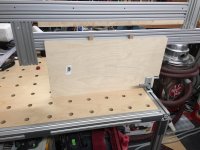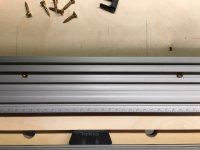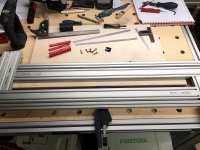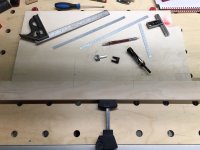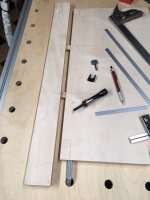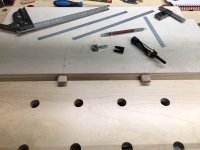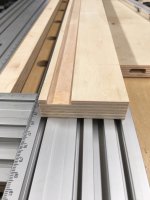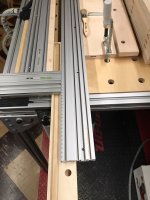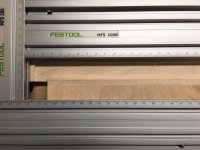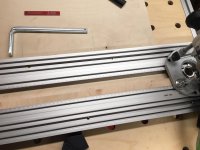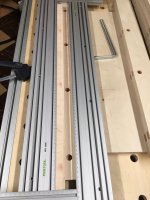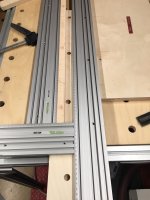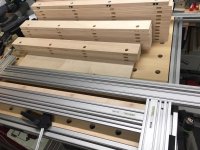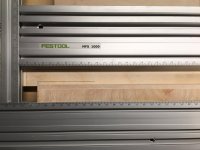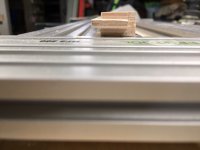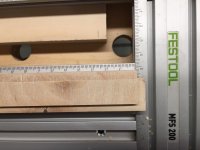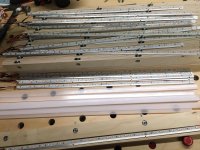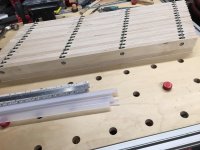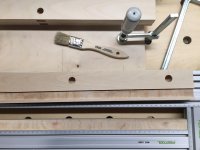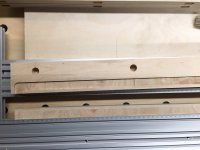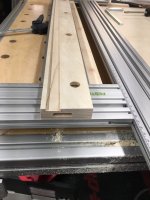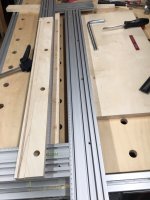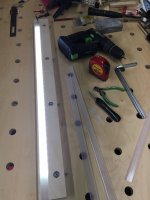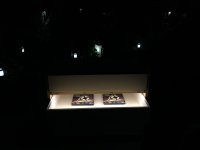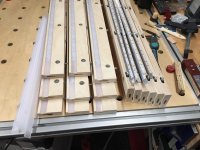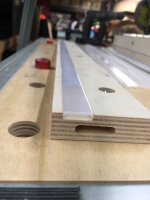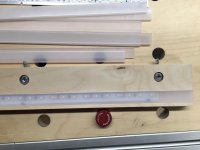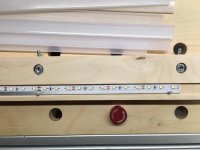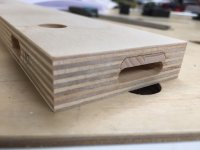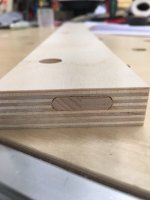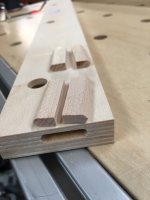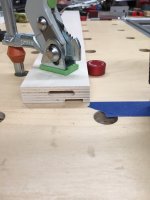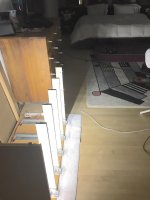Cheese
Member
- Joined
- Jan 16, 2015
- Messages
- 12,501
Some sister threads on LED lighting & a drawer front jig:http://festoolownersgroup.com/member-projects/installing-led-strips-and-other-led-issues/30/
https://www.festoolownersgroup.com/...drawers-for-false-fronts/msg600099/#msg600099
I'm building some cabinets that will be placed in the knee wall of the loft. Each drawer will have LED lights recessed into a stretcher above them. The lighting is controlled with micro switches so they'll activate automatically when the drawers are opened & closed.
The real issue is that because these cabinets will be over 10' long, I need to route out 20 stretchers. That's definitely not a job for clamping and then unclamping the MFS. The stretchers need to be loaded into a fixture, one at a time, indexed, routed, removed and then a new stretcher loaded again. This fixture will also allow each stretcher to be identical to each other and will dramatically speed up the process.
I've used a similar method in the past for producing multiples of HVAC vents and it works really well. The method centers around drilling holes in the MFS [eek] [eek] and screwing it to an indexing board. This indexing board will have 2 each 8mm dowels poking out the front and the tie-bars will have corresponding 8mm mortices for the new D8 knock down Dominos.
One end of the stretcher will be open while the other end needs to turn 90º to allow the wiring to exit. The width of the slot is critical because a plastic lens will be snapped in place to protect the LED's and to more evenly diffuse the light. The 90º turn also necessitated a wooden spacer be designed & installed in the MFS.
Here's a photo of each end of the stretcher.
[attachimg=1]
[attachimg=2]
The indexing board is a scrap piece of 18mm BB ply, the same material as the stretchers. It uses 2 Dominos that have had one end smoothed and radiused with sandpaper to more easily engage the tie-bar.
[attachimg=3]
Here the stretcher is being engaged with the indexing board and then clamped in place.
[attachimg=4]
[attachimg=5]
The MFS has been set to the proper size and is placed on the indexing board. I used gauge blocks to properly place the MFS as they are more accurate than pencil lines and faster.
[attachimg=6]
Two #9 GRK screws hold the MFS in place.
[attachimg=7]
Another plus with this setup is that once the MFS is attached, the entire assembly can be moved around and the registration is never lost. If you suddenly need the bench for another job, just pull the assembly and move it.
This shows the underside of the MFS and indexing board because I needed the bench for something else.
[attachimg=8]
https://www.festoolownersgroup.com/...drawers-for-false-fronts/msg600099/#msg600099
I'm building some cabinets that will be placed in the knee wall of the loft. Each drawer will have LED lights recessed into a stretcher above them. The lighting is controlled with micro switches so they'll activate automatically when the drawers are opened & closed.
The real issue is that because these cabinets will be over 10' long, I need to route out 20 stretchers. That's definitely not a job for clamping and then unclamping the MFS. The stretchers need to be loaded into a fixture, one at a time, indexed, routed, removed and then a new stretcher loaded again. This fixture will also allow each stretcher to be identical to each other and will dramatically speed up the process.
I've used a similar method in the past for producing multiples of HVAC vents and it works really well. The method centers around drilling holes in the MFS [eek] [eek] and screwing it to an indexing board. This indexing board will have 2 each 8mm dowels poking out the front and the tie-bars will have corresponding 8mm mortices for the new D8 knock down Dominos.
One end of the stretcher will be open while the other end needs to turn 90º to allow the wiring to exit. The width of the slot is critical because a plastic lens will be snapped in place to protect the LED's and to more evenly diffuse the light. The 90º turn also necessitated a wooden spacer be designed & installed in the MFS.
Here's a photo of each end of the stretcher.
[attachimg=1]
[attachimg=2]
The indexing board is a scrap piece of 18mm BB ply, the same material as the stretchers. It uses 2 Dominos that have had one end smoothed and radiused with sandpaper to more easily engage the tie-bar.
[attachimg=3]
Here the stretcher is being engaged with the indexing board and then clamped in place.
[attachimg=4]
[attachimg=5]
The MFS has been set to the proper size and is placed on the indexing board. I used gauge blocks to properly place the MFS as they are more accurate than pencil lines and faster.
[attachimg=6]
Two #9 GRK screws hold the MFS in place.
[attachimg=7]
Another plus with this setup is that once the MFS is attached, the entire assembly can be moved around and the registration is never lost. If you suddenly need the bench for another job, just pull the assembly and move it.
This shows the underside of the MFS and indexing board because I needed the bench for something else.
[attachimg=8]

